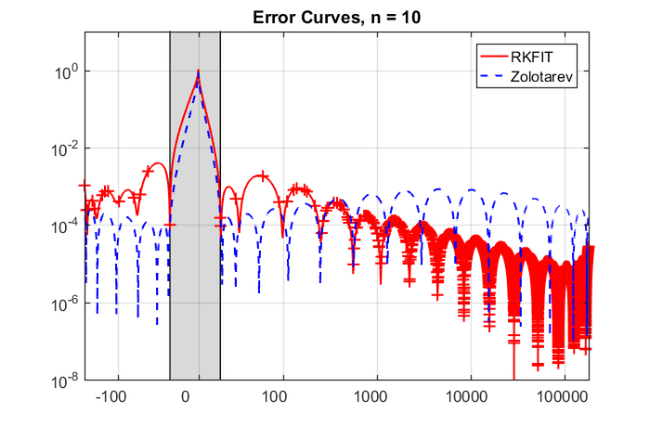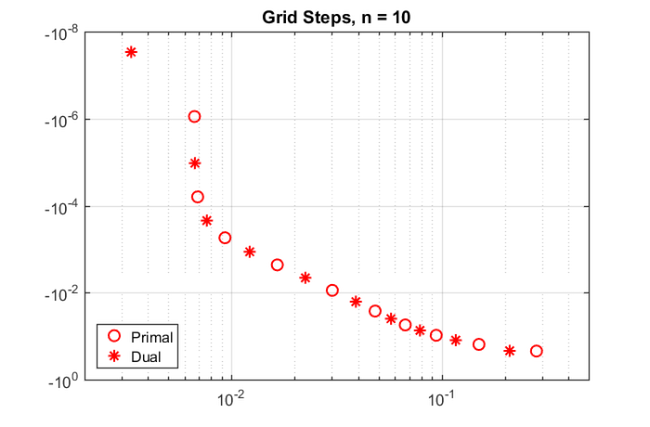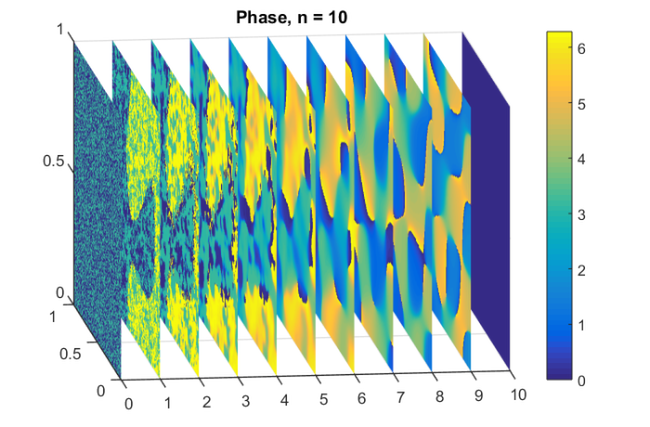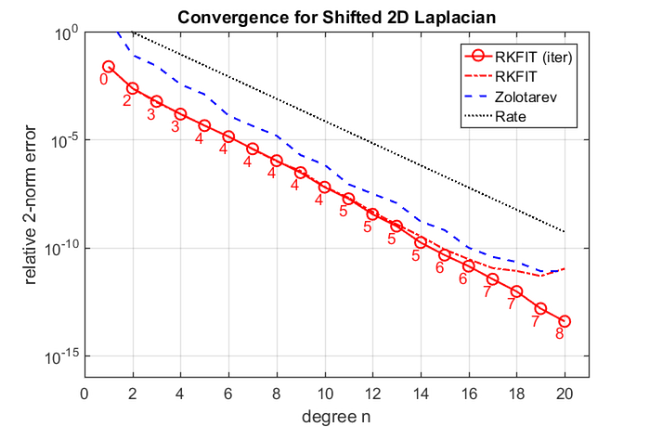Compressing exterior Helmholtz problems: 2D indefinite Laplacian
Stefan GüttelDownload PDF or m-file
Contents
Introduction
This script reproduces Example 6.2 in [2]. It computes RKFIT approximants for  , where
, where  is an indefinite matrix corresponding to the discretization of a 2D Laplacian on a square domain with Neumann boundary conditions; hence DCT2 can be used to diagonalize this matrix. The function to be approximated is
is an indefinite matrix corresponding to the discretization of a 2D Laplacian on a square domain with Neumann boundary conditions; hence DCT2 can be used to diagonalize this matrix. The function to be approximated is  . The RKFIT approximants are compared to the uniform two-interval Zolotarev approximants in [1].
. The RKFIT approximants are compared to the uniform two-interval Zolotarev approximants in [1].
The code
n = 150; N = n^2; h = 1/n; % grid step (now including boundary points for Neumann bcs) k = 15; L = gallery('tridiag',n); L(1,1) = 1; L(n,n) = 1; L2 = kron(speye(n),L) + kron(L,speye(n)); eeL = 2-2*cos(pi*(0:n-1)/n).'; % evs of L [ee1,ee2] = meshgrid(eeL); eeL2 = (ee1(:)+ee2(:)); % evs of L2 ordered for DCT % fL2v computes f(L2)*v using 2d DCT fL2v = @(f,v) reshape(idct2(reshape(f(eeL2) .* ... reshape(dct2(reshape(v,n,n)),N,1),n,n)),N,1); fL2V = @(f,V) util_colfun(@(v) fL2v(f,v),V); % matrix A and matrix-vector product AV A = 1/h^2*L2 - k^2*speye(N); AV = @(V) fL2V(@(z) z/h^2-k^2,V); % handles for rkfit AB.solve = @(nu, mu, x) fL2v(@(z) 1./(nu*(z/h^2-k^2)-mu),x); AB.multiply = @(rho, eta, x) fL2v(@(z) rho*(z/h^2-k^2)-eta,x); % multipy with f(A) fAV = @(f,V) fL2V(@(z) f(z/h^2-k^2),V); % multiply with analytic DtN map ee = sort(eeL2/h^2 - k^2).'; %ee = sort(eig(full(A))).'; %F = sqrtm(full(A) + (h*full(A)/2)^2); FV = @(V) fAV(@(z) sqrt(z+(h*z/2).^2),V); bt = randn(N,1); bt = bt/norm(bt); % training vector b = randn(N,1); b = b/norm(b); a1 = min(ee); b1 = max(ee(ee<0)); a2 = min(ee(ee>0)); b2 = max(ee);
Initialize RKFIT parameters.
param = struct; param.reduction = 0; param.k = 1; % superdiagonal param.tol = 0; param.real = 0; for m = 1:20, % in the paper [2] this is 25 % run rkfit with training vector param.maxit = 10; xi = inf*ones(1,m-1); % take m-1 initial poles [xi,ratfun,misfit,out] = rkfit(FV,AB,bt,xi,param); if m==1, err_rkfitt = out.misfit_initial; iter_rkfit = 0; else [err_rkfitt(m),iter_rkfit(m)] = min(misfit); iter_rkfit(m) = find(misfit <= 1.01*min(misfit),1); end % recompute best ratfun and compute error for vector b param.maxit = iter_rkfit(m); xi = inf*ones(1,m-1); % take m-1 initial poles [xi,ratfun,misfit,out] = rkfit(FV,AB,bt,xi,param); err_rkfit(m) = norm(FV(b) - fAV(ratfun,b))/norm(FV(b)); ex = @(x) sqrt(x + (h*x/2).^2); zolo = rkfun('sqrt2h',a1,b1,a2,b2,m,h); err_zolo(m) = norm(FV(b) - fAV(@(z) zolo(z),b))/norm(FV(b)); if m == 10, % some plots for m = 10 figure semilogy(NaN); hold on lint = util_log2lin([b1,a2],[a1,b1,a2,b2],.1); fill([lint(1:2),lint([2,1])], [1e-25,1e-25,1e15,1e15], ... .85*[1,1,1], 'LineStyle', '-') ylim([1e-8,10]) ax = [ -10.^(5:-1:2) , 0 , 10.^(2:5) ]; linax = util_log2lin(ax,[a1,b1,a2,b2],.1); %labels = num2str(ax(:),'%1.0G'); set(gca,'XTick',linax,'XTickLabel',ax) xx = [ -logspace(log10(-a1),log10(-b1),1000) , linspace(b1,a2,200) , ... logspace(log10(a2),log10(b2),1000) ]; xx = union(xx,ee); xxt = util_log2lin(xx,[a1,b1,a2,b2],.1); eet = util_log2lin(ee,[a1,b1,a2,b2],.1); hdl1 = semilogy(xxt,abs(ratfun(xx) - ex(xx)),'r-'); semilogy(eet,abs(ratfun(ee) - ex(ee)),'r+') hdl2 = semilogy(xxt,abs(zolo(xx) - ex(xx)),'b--'); legend([hdl1,hdl2],'RKFIT','Zolotarev ') xlim([0,1]) title(['Error Curves, n = ' num2str(m) ]) grid on set(gca,'layer','top') % plot residues figure [resid,xi] = residue(mp(ratfun),2); resid = double(resid); xi = double(xi); semilogy(xi,'rx') axis([-6.2e4,1.2e4,-5e3,-5]), hold on labels = num2str(abs(resid),'%0.1g'); hdl = text(real(xi)+1e3, imag(xi)*1.1, labels); set(hdl,'Color','r','FontSize',16,'Rotation',0) set(hdl(end),'Rotation',0) title(['Poles and Abs(Residues), n = ' num2str(m)]) grid on % plot grid steps figure [grid1,grid2,absterm,cnd,pf,Q] = contfrac(mp(ratfun)); grid1 = double(grid1); grid2 = double(grid2); loglog(grid1,'ro'), hold on loglog(grid2,'r*') legend('Primal','Dual','Location','SouthWest') title(['Grid Steps, n = ' num2str(m)]) grid on, axis([2e-3,5e-1,-1,-1e-8]) % plot solution slices figure U = out.V*double(Q); % first col = F*b, then U0,U1,etc. U(:,2) = b; % get rid of tiny imaginary parts if b is real Vol = []; % build volume object for j = 2:size(U,2), Vol(:,j-1,:) = reshape(U(:,j),n,n); end neps = min(min(min(abs(Vol))))/1; Vol(:,j,:) = zeros(n,n)+neps; [x,y,z] = meshgrid(0:1:j-1,linspace(0,1,n),linspace(0,1,n)); xslice = 0:1:j-1; yslice = []; zslice = []; hdl = slice(x,y,z,log10(abs(Vol)),xslice,yslice,zslice); set(hdl,'FaceAlpha',1,'LineStyle','none') set(gca,'Color',[0 0 0]), colorbar set(gca,'CLim',[-5,-2]), view(-7,16) set(gca,'XTick',0:100,'YTick',0:.5:1,'ZTick',0:.5:1) title(['Amplitude, n = ' num2str(m)]) figure Ang = angle(Vol); Ang(Ang<0) = 2*pi+Ang(Ang<0); hdl = slice(x,y,z,Ang,xslice,yslice,zslice); set(hdl,'FaceAlpha',1,'LineStyle','none') set(gca,'Color',[0 0 0]), set(gca,'CLim',[0,2*pi]) colorbar, view(-7,16) set(gca,'XTick',0:100,'YTick',0:.5:1,'ZTick',0:.5:1) title(['Phase, n = ' num2str(m)]) end end % for m





figure semilogy(err_rkfitt,'r-o'), hold on semilogy(err_rkfit,'r-.') semilogy(err_zolo,'b--') rate = exp(-2*pi^2/log((256*a1*b2/a2/b1))); semilogy(10*rate.^(1:m),'k:') ylim([1e-16,1]), xlim([0,m+1]) xlabel('degree n') ylabel('relative 2-norm error') legend('RKFIT (iter)','RKFIT','Zolotarev','Rate') labels = num2str(iter_rkfit(:),'%d'); hdl = text((1:m)-.4,err_rkfitt/10,labels,'horizontal','left','vertical','bottom'); set(hdl,'FontSize',13,'Color','r'), grid on title('Convergence for Shifted 2D Laplacian')

Conclusions
The main observation is that for this 2D problem the RKFIT approximants perform very similar to the uniform Zolotarev approximants. Compared to the 1D Laplacian example, no significant superlinear convergence effects are observed. Still the number of required RKFIT iterations is very small.
Other examples
The other examples in [2] can be reproduced with the following scripts:
Figure 1.2 - an infinite waveguide with two layers
Example 6.1 - constant coefficient and 1D indefinite Laplacian
Example 6.3 - uniform approximation on indefinite interval
Example 7.1 - truly variable-coefficient case with 2D indefinite Laplacian
References
[1] V. Druskin, S. Güttel, and L. Knizhnerman. Near-optimal perfectly matched layers for indefinite Helmholtz problems, SIAM Rev., 58(1):90--116, 2016.
[2] V. Druskin, S. Güttel, and L. Knizhnerman. Compressing variable-coefficient exterior Helmholtz problems via RKFIT, MIMS EPrint 2016.53 (http://eprints.ma.man.ac.uk/2511/), Manchester Institute for Mathematical Sciences, The University of Manchester, UK, 2016.